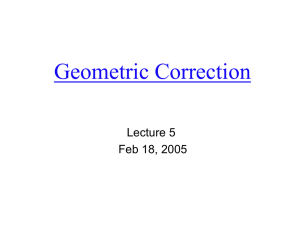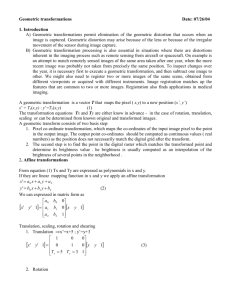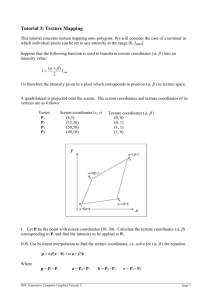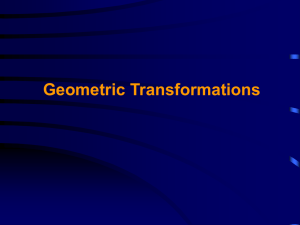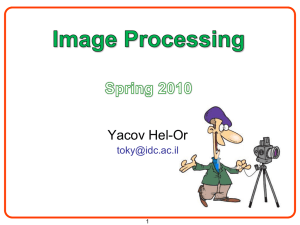Question 8 - Restoration
advertisement
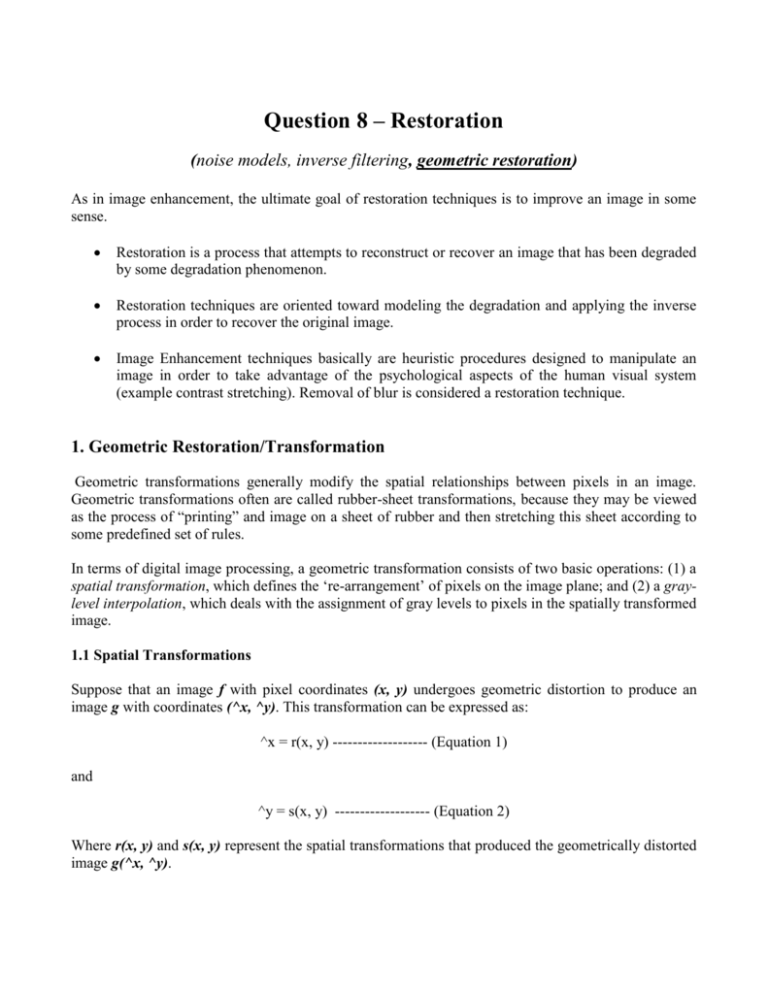
Question 8 – Restoration (noise models, inverse filtering, geometric restoration) As in image enhancement, the ultimate goal of restoration techniques is to improve an image in some sense. Restoration is a process that attempts to reconstruct or recover an image that has been degraded by some degradation phenomenon. Restoration techniques are oriented toward modeling the degradation and applying the inverse process in order to recover the original image. Image Enhancement techniques basically are heuristic procedures designed to manipulate an image in order to take advantage of the psychological aspects of the human visual system (example contrast stretching). Removal of blur is considered a restoration technique. 1. Geometric Restoration/Transformation Geometric transformations generally modify the spatial relationships between pixels in an image. Geometric transformations often are called rubber-sheet transformations, because they may be viewed as the process of “printing” and image on a sheet of rubber and then stretching this sheet according to some predefined set of rules. In terms of digital image processing, a geometric transformation consists of two basic operations: (1) a spatial transformation, which defines the ‘re-arrangement’ of pixels on the image plane; and (2) a graylevel interpolation, which deals with the assignment of gray levels to pixels in the spatially transformed image. 1.1 Spatial Transformations Suppose that an image f with pixel coordinates (x, y) undergoes geometric distortion to produce an image g with coordinates (^x, ^y). This transformation can be expressed as: ^x = r(x, y) ------------------- (Equation 1) and ^y = s(x, y) ------------------- (Equation 2) Where r(x, y) and s(x, y) represent the spatial transformations that produced the geometrically distorted image g(^x, ^y). For example if r(x, y) = x/2 and s(x, y) = y/2, the “distortion” is simply a shrinking of the size of f(x, y) by one-half in both spatial directions. If r(x, y) and s(x,y) were known analytically, recovering f(x, y) from the distorted image g(^x,^ y) by applying the transformations in reverse might be possible theoretically. In practice, however, formulating analytically a single set of functions r(x, y) and s(x, y) that describe the geometric distortion process over the entire image plane generally is not possible. The method used most frequently to overcome this difficulty is to formulate the spatial relocation of pixels by the use of tiepoints, which are a subset of pixels whose location in the input (distorted) and output (corrected) images is known precisely. Figure 1 below shows quadrilateral regions in a distorted and corresponding corrected image. Figure 1. Corresponding tiepoints in two image segments The vertices of the quadrilaterals are corresponding tiepoints Suppose that the geometric distortion process within the quadrilateral regions is modeled by a pair of bilinear equations, so that: r(x, y) ) = c1 x + c2 y + c3 x y + c4 ----------------------- (Equation 3) and s(x, y) ) = c5 x + c6 y + c7 x y + c8 ----------------------- (Equation 4) Then from equation 1 and 2: ^x = c1 x + c2 y + c3 x y + c4 ----------------------- (Equation 5) And ^y = c5 x + c6 y + c7 x y + c8 ----------------------- (Equation 6) Since there are total of eight known tiepoints, these equations can be easily solved for the eight coefficients ci, where i = 1,2, …., 8. The coefficients constitute the model used to transform all pixels within the quadrilateral region characterized by the tiepoints used to obtain the coefficients. In general, enough teipoints are needed to generate a set of quadrilaterals that cover the entire image, with each quadrilateral having its own set of coefficients. The procedure used to generate the corrected image is straightforward. For example, to generate f(0, 0), substitute (x, y) = (0, 0) into equation 5 and 6 and obtain a pair of coordinates (^x, ^y) from those equations. Then let f(0, 0) = g(^x, ^y), where ^x and ^y are the coordinate values just obtained. Next substitute (x, y) = (0, 1) into equation 5 and 6, obtain another pair of values (^x, ^y) and let f(0, 1) = g(^x, ^y) for those coordinate values. The procedure continues pixel by pixel and row by row until and array whose size does not exceed the size of image g is obtained. A column (rather than a row) scan would yield identical results. Also a bookkeeping procedure is essential to keep track of which quadrilaterals apply at a pixel location in order to user the proper coefficients. 1.2 Gray-level Interpolation The method just discussed (spatial transformation) steps through integer values of the coordinates (x, y) to yield the corrected image f(x, y). However depending on the coefficients ci, equations 5 and 6 can yield noninteger values for ^x and ^y. Because the distorted image g is digital, its pixel values are defined only at integer coordinates. Thus using noninteger values for ^x and ^y causes a mapping into locations of g for which no gray levels defined. Inferring what the gray level values at those locations should be, based only on the pixel values at integer coordinate locations, then becomes necessary. The technique used to accomplish this is called gray-level interpolation. The simplest scheme for gray-level interpolation is based on a nearest-neighbor approach. This method is, also called zero-order interpolation, is illustrated in figure 2 below. Spatial Transformation (^x,^ y) (x, y) Nearest neighbor to (^x, ^y) f(x, y) Gray-level assignment g(^x,^ y) Figure 2. Gray-level interpolation based on the nearest neighbor concept The above figure (figure 2), shows: (1) the mapping of integer coordinates (x, y) into fractional coordinates (^x, ^y) by means of equations 5 and 6; (2) the selection of the closest integer coordinate neighbor to (^x, ^y); and (3) the assignment of the gray-level of this nearest neighbor to the pixel located at (x, y). Although nearest neighbor interpolation is simple to implement, this method often has the drawback of producing undesirable artifacts, such as distortion of straight edges in images of fine resolution. Smoother results can be obtained by using more sophisticated techniques, such as cubic convolution interpolation, which fits a surface of (sin x)/x type through a much larger number of neighbors (say 16) in order to obtain a smooth estimate of the gray level at any desired point. However, from a computational point of view this technique is costly, and a reasonable compromise is to use a bilinear interpolation approach that use the gray levels of the four nearest neighbors. In other words, the idea is that the gray level of each of the four integral nearest neighbors of a non-integral pair of coordinates (^x, ^y) is known. The gray-level value of (^x, ^y), denoted v(^x, ^y), can then be interpolated from the values of its neighbors by using the relationship: v(^x, ^y) = a ^x + b ^y + c ^x ^y + d ---------- (Equation 7) where the four coefficients are easily determined from the four equations in four unknowns that can be written using the four neighbors of (^x, ^y). When these coefficients have been determined, v(^x, ^y) is computed and this value is assigned to the location in f(x, y) which yielded the spatial mapping into location (^x, ^y). Figure 3. (a) Distorted image; (b) image after geometric correction
